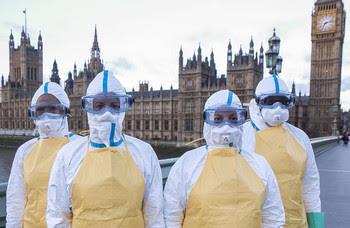With Ebola remaining a cause for concern in the Democratic Republic of Congo (DRC), Johanna, one of our travel nurses who’s had first-hand experience during the 2014 outbreak, looks at the differences between the current outbreak compared to her experience.
During the 2014 outbreak, I was stationed in an Ebola treatment centre in Sierra Leone. The UK government responded to the Ebola outbreak by sending out British medical professionals to help support the Ebola response unit. It was a time in my life when I didn’t have responsibilities that tied me to a fixed geographic location, alongside having the necessary skills that could make a difference, so there really didn’t seem a reason not to go to help out.
The current outbreak is happening in the Democratic Republic of the Congo (DRC).
The General-Director of the World Health Organisation recently visited Ebola-affected areas in the DRC and reported:
‘Since the outbreak began in August 2018, there have been 608 cases and 368 deaths in North Kivu and Ituri provinces. To date, more than 54,000 high-risk contacts and frontline responders have been vaccinated, and almost every new patient receives one of four investigational treatments, something which was never previously possible during an Ebola outbreak.
The main challenges are the security environment, pockets of mistrust among affected populations, and poor infection prevention and control in many public and private health facilities. Under the government’s leadership and working collaboratively with UN and NGO partners, WHO is committed to addressing these challenges and ending the outbreak.
There are many factors that make this current outbreak vastly different to the 2014 outbreak:
- Regional Stability
The political situation in the DRC is unstable which has led to less infrastructure to support relief efforts and virus control activities. Healthcare providers may be at risk of violence which makes a difficult job even harder. Civil unrest has lead to more than 1 million people being forced to leave their homes to escape potential violence, this mass movement of people means the spread of the virus is harder to control. This creates a very different context to the one we were facing in Sierra Leone.
Source: The New England Journal of Medicine: New tools in the Ebola arsenal, United Nations High Commissioner for Refugees: Spiralling violence puts millions at risk in Ebola-hit eastern DRC. August 24, 2018
- Public Awareness
At the beginning of the 2015 outbreak, there was very limited public awareness of the Ebola virus and how it is spread. The understanding of Ebola transmission was minimal and communities were unaware that some traditional practices could be increasing the risk of infection. The outbreak in 2015 involved a very steep learning curve for all involved. The many lessons learnt then will mean that there is more knowledge, resources and information to fight the virus this time around.
According to The Lancet:
In 2016, Guinea, Liberia, and Sierra Leone succeeded in interrupting the longest epidemic of Ebola virus disease in global history…Control of the epidemic was primarily achieved by implementation of effective and coordinated public health measures that involved rapid identification, isolation of cases, contact tracing, and isolation of contacts.
Source: The Lancet: Prevention of Ebola virus disease through vaccination: where we are in 2018
- Ebola Vaccine
One of the major developments in the armoury of tools to fight Ebola is the development of an Ebola vaccine. This was only a dream in the 2015 outbreak but it is a reality for the healthcare professionals currently working in the DRC. Although still in its early stages, the Ebola vaccine in use in the DRC is showing very promising results. In May and June of 2018 more than 3,000 people were vaccinated as part of the WHO response to the Ebola virus.
Source: The Lancet: Prevention of Ebola virus disease through vaccination: where we are in 2018
- Safer working conditions
Treating patients in the 2015 outbreak was very difficult for many reasons. One of the hardest things was finding a balance between safety from infection and being able to provide effective and compassionate care. Working in the hazmat suits kept us safe from transmission of the disease, but working in 40-degree heat wrapped up in layers of plastic was very inconvenient for many reasons. Being so hot meant that we could not spend as much time with our patients as we would have liked because there were limits to how much time we could spend in the Red Zone for our own safety. Being so covered up also made it harder to form human relationships with our patients (which is the cornerstone of nursing practice) because it was difficult for our patients to distinguish between us and any chance of communication through facial expressions was impossible.
The current outbreak has seen the introduction of air-conditioned Ebola treatment cubicles which eliminates the need for such restrictive time constraints whilst also offering a healthier environment for medical professionals.
According to the New England Journal of Medicine:
With such cubicles, health care workers can provide intravenous fluids and therapeutics through specialized ports and are thus freed from the burdensome personal protective equipment used during the 2014 West African outbreak to spend more time with their patients. Medcins sans Frontieres (MSF, or Doctors without Borders) continues to be a leader in developing safe care for patients with EVD provided in structures that can be rapidly erected using local resources.
Sources: The New England Journal of Medicine: New tools in the Ebola arsenal
- Containment of the outbreak
This outbreak is considered a contained case with little spread outside of the outbreak origin. The 2015 outbreak quickly moved across international borders and therefore was a cause of much concern for the international community. People are obviously anxious about the spread of Ebola, however, at this stage, the risk is minimal within Europe. There are many precautions taken by all those returning to the UK from affected areas.
When returning from Sierre Leone, I was subject to 3-week quarantine monitored by Public Health England during which I had to report my temperature to them twice a day and there were numerous restrictions on what I could and couldn’t do such as, I couldn’t work in hospitals, I could get my hair cut but not shaved, I couldn’t get a pedicure nor go to places with large amounts of people including football matches and music concerts. Everything was extremely well monitored and the public was kept incredibly safe from infection. These practices are no-doubt to be in place for this current outbreak as well.
______________________________
If you have any concerns about travelling to parts of Africa, you can book a travel consultation for the latest travel health advice for your destination.
By Johanna Bosowski | Travel Nurse | February 2019



